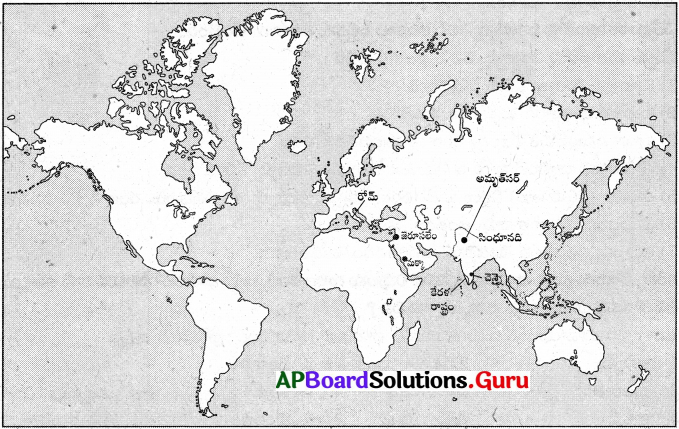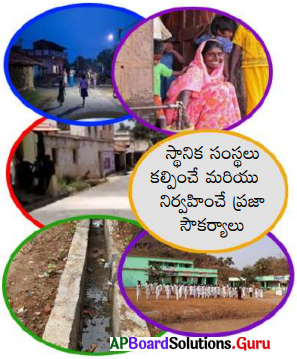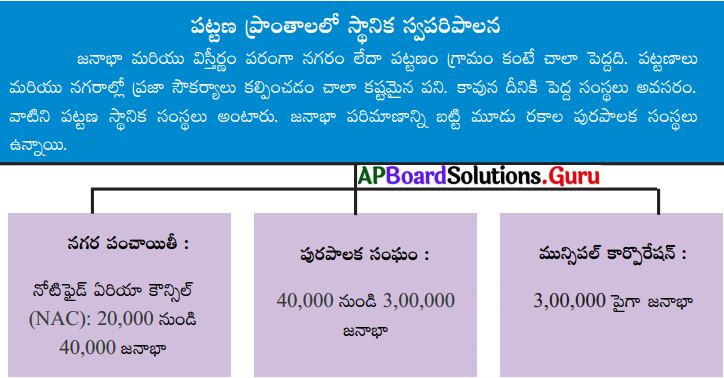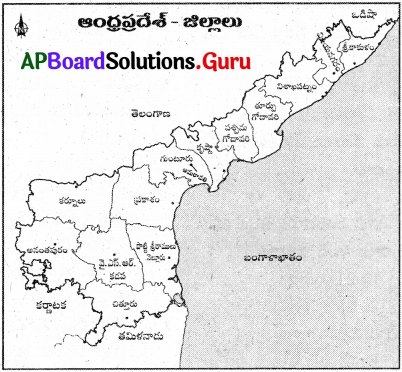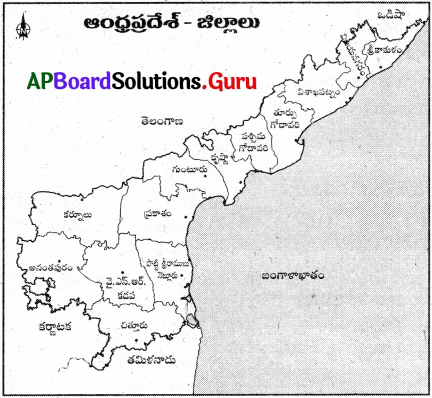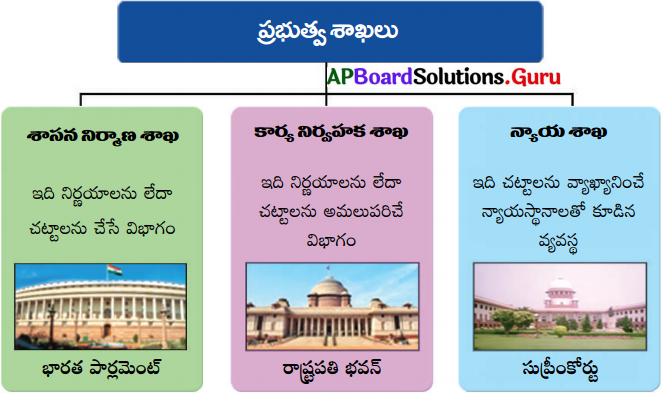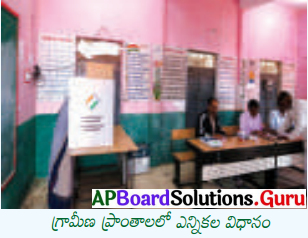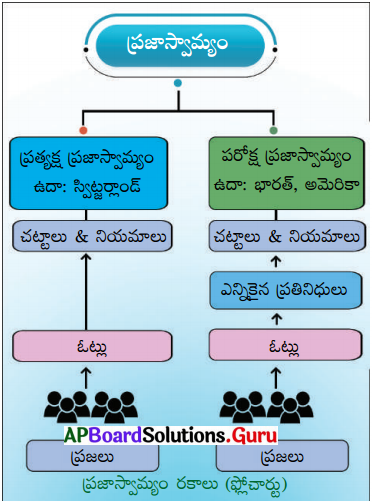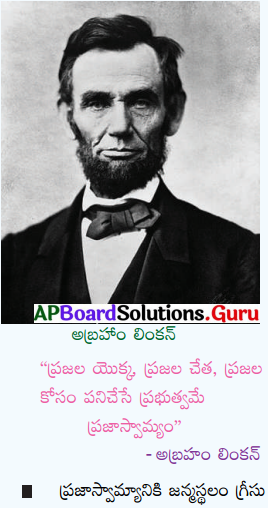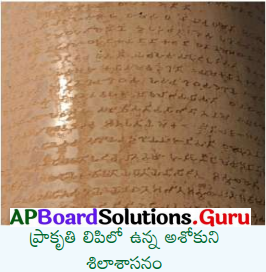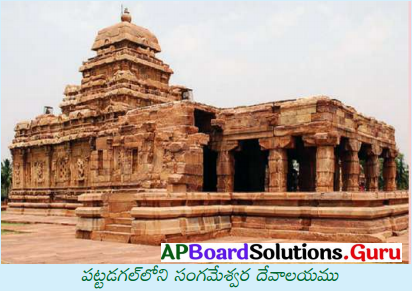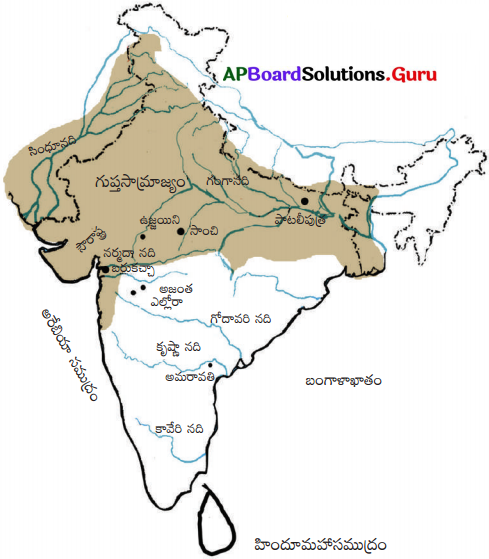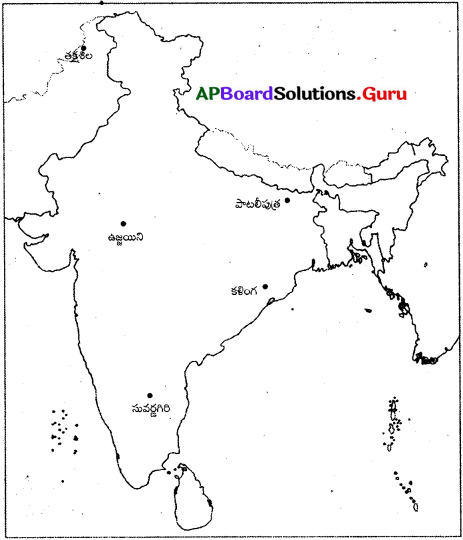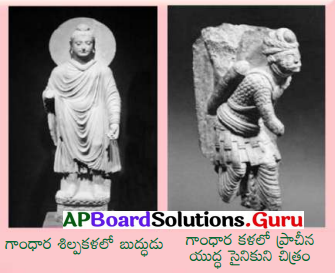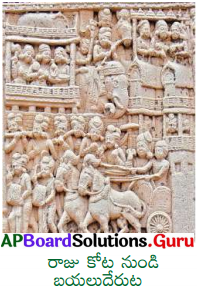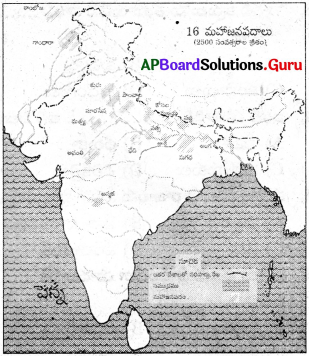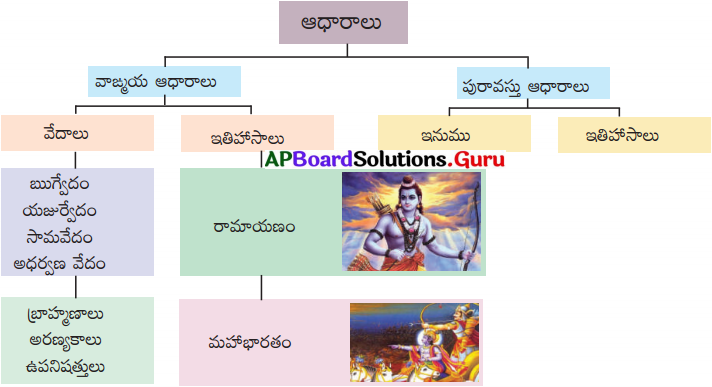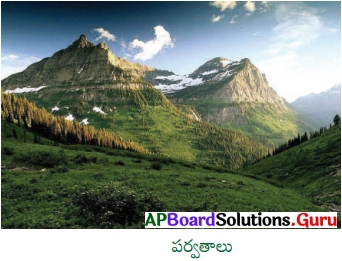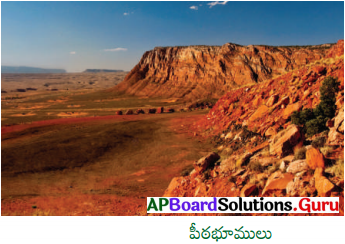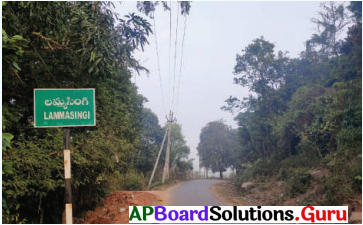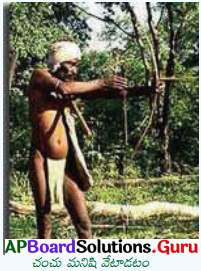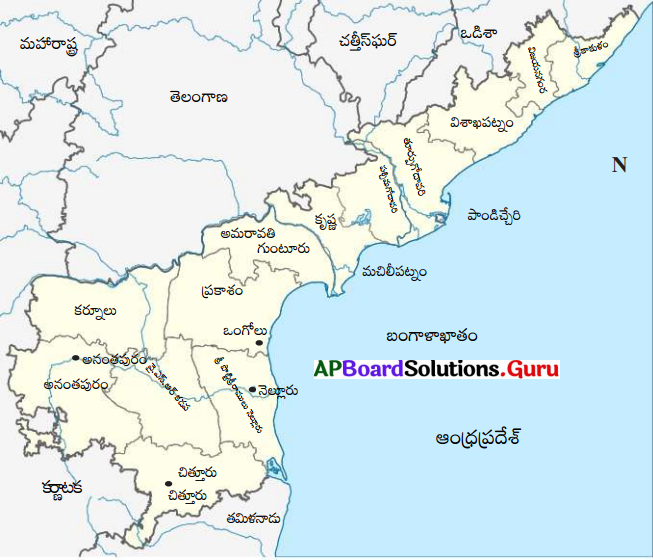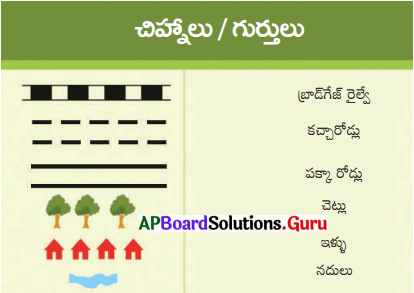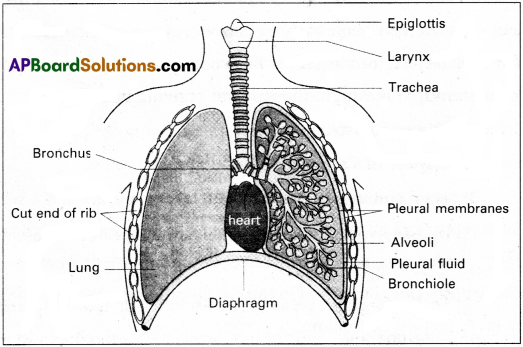These AP 7th Class English Important Questions 8th Lesson Gurajada – The Legend will help students prepare well for the exams.
AP Board 7th Class English Unit 8 Important Questions and Answers Gurajada – The Legend
Reading Comprehension (Seen)
1. Read the following passage carefully.
Many scholars, writers, and historians have praised him as a revolutionary in his thought. He brought out a bloodless revolution in both the literary and social spheres. He revolutionized theme and treatment, he rescued language from the learned and gave it back to people, the ultimate creators of the language. He looked ahead of his time, with a broad vision.
Having strong faith in spoken Telugu, Gurajada in a letter to one of his disciples opined, “My cause is the cause of the people and 1 have a cultured opinion at my back. I do not mind the people who fight against me without understanding the issue. Their conversion can do no good to the language. They are so hopelessly wedded to the old, highly artificial literary dialect.” (Gurajada – The Legend)
Now, answer the following questions.
1. Who had revolutionary thoughts?
Answer:
Gurajada Apparao
2. What did he rescue from the learned?
Answer:
Language
3. Who are the ultimate creators of a language?
Answer:
People who speak a language
4. What did Gurajada believe in?
Answer:
In spoken Telugu
5. What is the cause of the people?
Answer:
They want literature in their spoken language.

2. Read the following passage carefully.
His dream and vision were of a new social system. His attitude towards women’s education, social equality, and widow re-marriages are all surprisingly modern.
The year 1911 is significant in the history of modern Telugu literature as the movement for spoken dialect was started by Gidugu and Gurajada.
They paved path to the modernity of Telugu language by introducing everyday used words, homely phrases and common place idioms, expressions most familiar to all ears from peasant to the priest, from prince to the poor. The characters in his works are high-spirited and have modern outlook. His style of writing is simple yet sublime in meaning.
In 1912, being inspired by the work done by Gurajada, the Bangeeya Sahithya Parishat (The Bengal Literary Association) which was run by the legends of Bengal like Rabindranath Tagore, Romesh Chander Dutt, and Syamendra Mohandas, invited Gurajada to attend a meeting at Calcutta now called Kolkata. (Gurajada – The Legend)
Now, answer the following questions.
1. What were his dream and vision?
Answer:
A new social system
2. Why was 1911 a significant year?
Answer:
The movement for spoken dialect was started by Gidugu and Gurajada.
3. What was the nature of the characters in his works?
Answer:
His characters are high-spirited and have modern outlook.
4. Who were the legends of Bengal as mentioned in this passage?
Answer:
Rabindranath Tagore, Romesh Chander Dutt and Syamendra Mohandas
5. Why was Gurajada invited to Bengal?
Answer:
To attend a meeting at Calcutta
3. Read the following passage carefully.
Grace and dignity must be given to the language not by the ornamental words but by noble, simple, lucid, powerful, and straight forward ideals. Finally, he retired in 1913 and the Madras University honoured him with the title “Emeritus Fellow”. He passed away on 30th November 1915 leaving behind the legacy of immortal literature for future generations. No library is complete without the works of the lei endary writer Gurajada. (Gurajada – The Legend)
Now, answer the following questions.
1. What should be given grace and dignity?
Answer:
Language
2. When did he retire?
Answer:
He retired in 1913.
3. How did the Madras University honour him?
Answer:
With the title “Emeritus Fellow”
4. When did he pass away?
Answer:
On 30fh November 1915
5. Who was the legendary writer?
Answer:
Gurajada Apparao
4. Read the following passage carefully.
Once upon a time, there lived a boy. He used to lose his temper very quickly and become angry. He would scold kids, neighbours, and even his friends. So, his friends and neighbors ignored him.
His mother and father tried to explain his mistake to him in all possible ways. But all their attempts failed.
One day his father thought of an idea. He gave his son a huge bag of nails. He told his son that whenever he lost his temper, he had to hammer a nail into the fence. The boy found this very funny but agreed to do what his father had said.
On the first day he drove 30 nails into the fence. On the next day the number of nails hammered reduced to half. The boy fdund hammering the nails very difficult and decided to control his anger. The number of nails he hammered every day kept reducing and the day came when no nail was hammered into the fence. (Nails in the Fence)
Now, answer the following questions.
1. What was the problem with the boy?
Answer:
He used to lose his temper very quickly and become angry.
2. How did the boy behave with friends?
Answer:
He would scold them.
3. How many times did he get angry on the first day?
Answer:
30
4. What happened gradually?
Answer:
The boy’s anger reduced.
5. No nail was hammered into the fence. What does this mean?
Answer:
This means that the body did not get angry.

5. Read the following passage carefully.
After some days, the boy told his father that it had been several days since he had hammered a nail into the fence. Then his father told him to gradually remove some of the nails every day. Soon the boy had removed almost all the nails except a few. These were hammered too deeply to remove.
Then his father asked, ‘What do you see there?’
‘Holes in the fence,’ the boy replied.
His father said, ‘The nails were like the bad words you hammered onto people. They left a scar on the people’s minds. You removed almost all the nails but the holes they left could not be removed. The nails you could not remove are like the permanent scars on people’s minds. They will remain there forever.’
The boy understood his mistake and promised his parents that he would be a kind and polite boy. (Nails in the Fence)
Now, answer the following questions.
1. What did the boy tell his father one day?
Answer:
It had been several days since he had hammered a nail into the fence.
2. Why could he not remove some of the nails?
Answer:
Because they were hammered too deeply to remove.
3. What did the boy see in the fence after removing the nails?
Answer:
Holes
4. What were the nails compared with?
Answer:
The nails were compared with bad words.
5. What did the boy promise his parents?
Answer:
The boy promised his parents that he would be a kind and polite boy.
Reading Comprehension (Unseen)
1. Read the following passage carefully.
Annie and Rosa were walking home. It was just getting dark. They got to the big, gray house. They always hated walking by that house. It was old and empty. It had many broken windows. Everyone said it was haunted.
As they went by, they heard a strange noise. It sounded like a baby cry. They stopped and looked around but could not see anyone. The noise was coming from the house.
Rosa was very brave. She walked all the way up to the house. Suddenly Rosa be¬gan to laugh. She pointed to the roof and said, “Look, Annie, there’s our ghost.”
Annie looked. The noise was coming from a sacred little kitten. The kitten was stuck on the roof. “Sometimes things are not what they seem,” Annie said.
Now, answer the following questions.
a) What is the story about?
Answer:
The story is about a strange noise in a big, gray house.
b) What caused the strange noise?
Answer:
A sacred little kitten struck on the roof causing the strange noise.
Choose the correct answer:
c) When did the story take palce?
i) early morning
ii) noon time
iii) late afternoon
Answer:
iii) late afternoon
d) What kind of person is Rosa?
i) sad
ii) tired
iii) brave
Answer:
iii) brave
e) They always hated the house because
i) it was old and empty.
ii) a ghost was living in it.
iii) everyone said it was haunted.
Answer:
i) it was old and empty.

2. Read the following passage carefully.
The Great Sphinx is a lion with the head of person cut out of rock. It is a statue located in Egypt. Legends have been told about the Great Sphinx. Many of these stories talk about the sphinx being strong and wise. The statue is very large. The whole statue is 150 feet long with 50 feet long paws. The head is 30 feet long and 14 feet wide. Wind and sand have worn parts of the statue’s nose and some other parts of the statue away completely. These parts will be rebuilt to look as good as new. This process is called restoring.
Now, answer the following questions.
a) Why is the sphinx getting fixed?
Answer:
Wind and sand have worn out parts of the statue’s nose and some other parts of the statue away completely.
b) What is called restoring?
Answer:
The process of the fixation of the worn out parts of the statue of sphinx is called restoring.
Choose the correct answer :
c) Sphinx is located in ………………
i) France
ii) Egypt
iii) America
Answer:
ii) Egypt
d) How long are the paws of the sphinx?
i) 150 feet
ii) 50 feet
iii) 30 feet
Answer:
ii) 50 feet
e) Sphinx is a statue with
i) the head of a lion and the body of a man.
ii) the head of a tiger and the body of a lion.
iii) the head of a person and the body of a lion.
Answer:
iii) the head of a person and the body of a lion.
Interpretation of Non-Verbal Information
1. Study the following pie diagram carefully.
Distribution of annual income of Ramesh on savings and expenditure

Now, answer the following questions.
a) What does the above pie diagram describe?
Answer:
Distribution of annual income of Ramesh on savings and expenditure.
b) What is the second highest expenditure of Ramesh?
Answer:
House rent.
Choose the correct answer from the choices given.
c) Ramesh spends the most on ………………..
i) taxes
ii) clothes
iii) miscellaneous
Answer:
i) taxes
d) Ramesh spends the least on ……….
i) taxes
ii) clothes
iii) food
Answer:
ii) clothes
e) Which of the following statements is true with reference to the information given above?
i) Ramesh spends equally on clothing and miscellaneous items.
ii) Ramesh does not have any savings.
iii) Ramesh spends more on clothing than food.
Answer:
i) Ramesh spends equally on clothing and miscellaneous items.
2. Read the following table.
Number of Engineering students at different institutes

Now, answer the following questions.
a) What does the table show?
Answer:
The table shows the number of engineering students studying at different institutes during the period 1988-89 to 1990-91.
b) What is the general trend of Engineering education?
Answer:
The general trend of engineering education has shown consistent growth during the given period.
Choose the correct answer from the choices given.
c) What was the total number of engineering students in 1989 – 90?
i) 38500
ii) 41500
iii) 42500
Answer:
ii) 41500
d) In which category of Engineering colleges highest number of students are studying Engineering?
i) IITs
ii) Govt. Engineering Colleges
iii) Private Engineering Colleges
Answer:
iii) Private Engineering Colleges
e) In which category of colleges lowest number of students are studying Engineering?
i) IITs
ii) Govt. Engineering Colleges
iii) Regional Engineering Colleges
Answer:
i) IITs
Vocabulary
Synonyms
Choose the words with similar meanings (synonyms) from the list given to the words underlined.
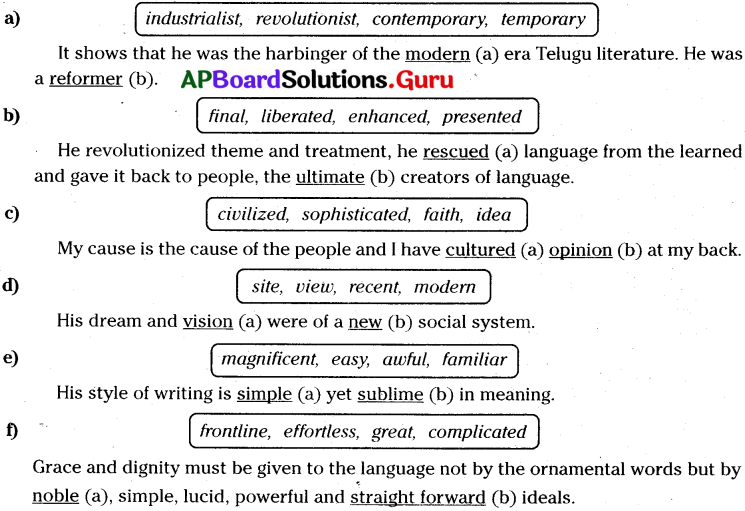
Answer
a) a) contemporary, b) revolutionist
b) a) liberated, b) final
c) a) civilized, b) idea
d) a) view, b) modern
e) a) easy, b) magnificent
f) a) great, b) effortless
Antonyms
Write the opposites (antonyms) for the underlined words.
a) Having strong faith (a) in spoken Telugu, Gurajada in a letter to one of his disciples opined, “My cause is the cause of the people and I have cultured (b) opinion at my back”.
b) They are so hopelessly (a) wedded to the old, highly artificial (b) literary dialect.
c) His dream and vision were a new (a) social system. His attitude towards women’s education, social equality (b) and widow re-marriages are all surprisingly modern.
d) The year 1911 is significant (a) in the history of modern (b) Telugu literature as the movement for spoken dialect was started by Gidugu and Gurajada.
e) Grace and dignity (a) must be given to the language not by the ornamental words but by noble, simple, lucid (b), powerful and straight forward ideals.
f) He passed away on 30th November 1915 leaving behind the legacy of immortal (a) literature for future generations. No library is complete (b) without the works of the legendary writer Gurajada.
Answer:
a) a) disbelief, b) unrefined
b) a) hopefully, b) natural
c) a) old, b) inequality
d) a) unimportant, b) ancient
e) a) worthlessness, b) ambiguous
f) a) temporary, b) incomplete
Right Forms of the Words
Fill in the blanks with the right form of the words given in the brackets.
a) Many scholars, writers and _____ (a) (history / historians) have praised him as a _____ (b) (revolutionary / revolution) in his thought.
b) Their _____ (a) (conversion / convert) can do no good to the language. They are so _____ (b) (hopeless / hopelessly) wedded to the old, highly artificial literary dialect.
c) Gurajada was _____ (a) (naturality / naturally), an artist. He viewed the world with a painter’s brush and writer’s _____ (b) (creation / creative) pen.
d) His attitude towards women’s _____ (a) (education / educated), social equality and widow re-marriages are all _____ (b) (surprising / surprisingly) modern.
e) In his letter he felt sorry that he had not met him to talk on the subject of introducing a _____ (a) (suitable / suitability) style in the vernaculars and the _____ (b) (presence / present) tendency of modern Bengali.
f) Tagore _____ (a) (maintenance / maintained) a constant touch with Mahakavi Gurajada on his works and social _____ (b) (reforms / reformer).
Answer:
a) a) historians, b) revolutionary
b) a) conversion, b) hopelessly
c) a) naturally, b) creative
d) a) education, b) surprisingly
e) a) suitable, b) present
f) a) maintained, b) reforms
Spelling Test
Type – 1 : Vowel Clusters
Complete the following words using “ae, ai, au, ea, ee, ei, eo, ia, ie, io, iu, oi, oo, ou, ua or ui”.
a) Many scholars, writers and historians have praised him as a revolut _ _ nary in his th _ _ ght.
b) He revolutionized theme and tr _ _ tment, he rescued language from the learned and gave it back to p _ _ pie, the ultimate creators of language.
c) Their convers _ _ n can do no good to the lang _ _ ge.
d) They paved path to the modernity of Telugu language by introducing everyday used words, homely phrases and common place idioms, express _ _ ns, most familiar to all ears from p _ _ sant to the priest, from prince to the poor.
e) After Gurajada had visited Tagore, he wrote an article on the experiences and impress _ _ ns of their m _ _ ting.
f) Tagore m _ _ ntained a constant t _ _ ch with Mahakavi Gurajada on his works and social reforms.
Answer:
a) revolutionary, thought
b) treatment, people
c) conversion, language
d) expressions, peasant
e) impressions, meeting
f) maintained, touch

Type – 2 : Suffixes
Complete the following words with the suitable suffixes given in the brackets.
a) He was a social reform ____ (er / or). Many scholars, writers and histor ____ (yians / ians) have praised him as a revolutionary in his thought.
b) They are so hopeless ____ (ly / lly) wedded to the old, high ____ (lly / ly) artificial literary dialect.
c) His attitude towards women’s educat ____ (ian / ion), social equal ____ (yity / ity) and widow re-marriages are all surprisingly modern.
d) The year 1911 is significant in the history of modern Telugu literat ____ (ure / are) as the move ____ (ment / mant) for spoken dialect was started by Gidugu and Gurajada.
e) Finally, he retired in 1913 and the Madras University honour ____ (ed / d) him with the title “Emeritus Fellow”. He passed away on 30th November, 1915 leaving behind the legacy of immortal literature for future generat ____ (ians / ions).
f) I had been forced to go through a very great dissipat ____ (ian / ion) of mind for a long time – so I have taken shelter here in the soli ____ (hide/ ttude) of Himalayas to gather my scattered forces and regain my spiritual equilibrium.
Answer:
a) reformer, historians
b) hopelessly, highly
c) education, equality
d) literature, movement
e) honoured, generations
f) dissipation, solitude
Type – 3 : Wronalv Smelt Words
Identify the wrongly spelt word and write its correct spelling in the space provided.
a) literature, dialect, impresion, regain
Answer:
impression
b) revolutionery, modernity, dignity, force
Answer:
revolutionary
c) sphere, language, ornamental, equilybrium
Answer:
equilibrium
d) rescue, familier, legacy, spiritual
Answer:
familiar
e) ultimate, peasant, legendery, least
Answer:
legendary
f) braod, character, immortal, demand
Answer:
broad
Classification of Words
Arrange the following words under the correct headings.
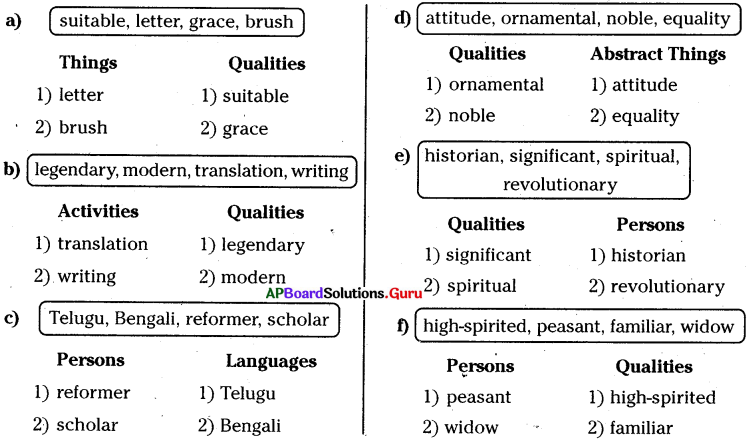
Choice of the Words
Fill in the blanks choosing the suitable words from those given in the box.

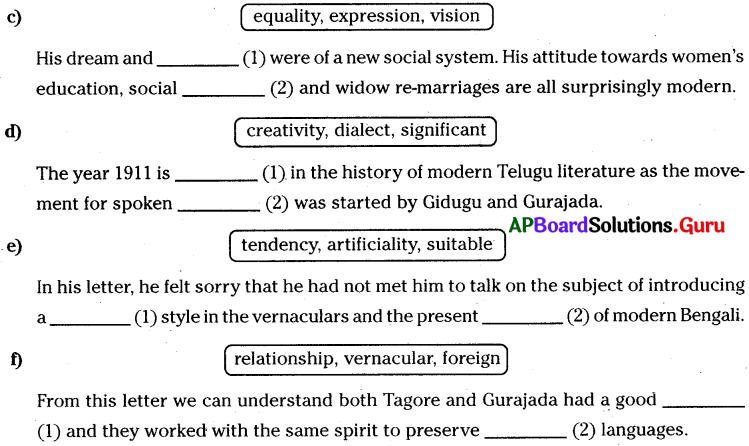
Answer:
a) 1) revolutionized, 2) rescued
b) 1) conversion, 2) hopelessly
c) 1) vision, 2) equality
d) 1) significant, 2) dialect
e) 1) suitable, 2) tendency
f) 1) relationship, 2) vernacular
Exercise on Antonyms
(Forming Antonyms by adding ‘ir’, ‘dis’, ‘im’ ‘mis’, and ‘in’ to the given words)
Fill in the blanks with the antonyms of the underlined words.
a) He always agrees with her wife but she ________ with him.
b) Don’t be ________ with elders, be polite with them.
c) You always ________ me, please try to understand me.
d) I take great comfort in Aruna’s company but feel ________ in Sunitha’s company.
e) Your project work is ________ . When will you complete it?
Answer:
a) disagrees
b) impolite
c) misunderstand
d) discomfort
e) incomplete
Grammar
I. Edit the following passage correcting the underlined parts.
1. A (a) anagram is the rearrangement of the letters of a word, name, phrase, sentence, title, or the like into another word but (b) phrase. But all the letters of the phrase must be use (c) once and only once. This is the basic rule at (d) anagramming.
Answer:
a) An b) or c) used d) of
2. A young man named Aditya helped a tiger, a snake and a goldsmith which (a) were stuck in a well. The tiger is (b) grateful but (c) gave Aditya jewellery. Aditya brought the jewellery to her (d) friend, the goldsmith.
Answer:
a) who b) was c) and d) his
3. Last Sunday, it is (a) very cloudy. My friends and I visited an (b) zoo. Since (c) we approached the main gate, we saw a huge crowd. Some people were buying tickets, some were chatting while others were relaxing along (d) the shady trees.
Answer:
a) was b) the c) As d) under
4. The lion was (a) a wild animal. Forests or jungles are the natural habitats with (b) lions. The lion is called the ‘King of the Jungle as (c) of its strength and power. It is a carnivore where (d) means that it eats the flesh of other animals.
Answer:
a) is b) of c) because d) that

II. Complete the passage choosing the right words from those given below. Each blank is numbered and for each blank four choices are given. Choose the correct answer and write (A), (B), (C) or (D) in the blanks.
1. Corona viruses are a group ______ (1) related RNA viruses that cause diseases in mammals and birds. In humans and birds, they cause respiratory tract infections that can ______ (2) from mild to lethal. Mild illnesses in humans include some cases of ______ (3) common cold, while moral lethal varieties can cause SARS, MERS and C0VID -19. In cows ______ (4) pigs they cause diarrhea.
1) A) in B) at C) by D) of
2) A) caused B) cause C) causes D) causing
3) A) a B) an C) the D) these
4) A) and B) but C) if D) yet
Answer:
1) D 2) B 3) C 4) A
2. English language is really considered as ______ (1) significant language since it has been used for communicating worldwide. Therefore, learning English is very common in many countries and language learning styles, especially reading styles are learned ______ (2) by students in globalization. More importantly, language learning styles ______ (3) the core factors that help decide ______ (4) the students learn a foreign language.
1) A) an B) a C) the D) those
2) A) differently B) different C) difference D) differentiate
3) A) was B) is C) were D) are
4) A) how B) why C) which D) who
Answer:
1) B 2) A 3) D 4) A
3. Once upon a time, when Brahmadatta. family of a certain village of Kasi ______ (1) king of Benares, there was in a family of certain village of Kasi ______ (2) only son named Vasitthaka. This man ______ (3) his parents, and after his mother’s death, ______ (4) looked after his father.
1) A) an B) is C) was D) were
2) A) the B) an C) a D)these
3) A) supported B) support C) supports D) will support
4) A) we B) they C) she D) he
Answer:
1) C 2) B C) a 3) A 4) D
4. A poor man was walking through ______ (1) forset. He saw a ______ (2) tiger which ______ (3) a gold bracelet with him. The tiger asked the poor man to take the bracelet. The poor man believed ______ (4) cunning words. He went near the tiger to take the bracelet. The tiger jumped at him and killed him.
1) A) a B) an C) the D) any
2) A) hunger B) hungry C) hungrily D) hungerly
3) A) had B) has C) have D) having
4) A) him B) his C) them D) their
Answer:
1) A 2) B C) A 4) B
III. Fill in the blanks with the right form of the verb given in the brackets.
1) Our teacher _______ (scold) all of us yesterday.
2) She was very tired, so she _______ (go) to bed early.
3) Sarojini Naidu _______ (write) a number of poems.
4) Columbus _______ (discover) America.
5) I _______ (see) a cobra one hour ago.
6) What _______ (do) you eat for dinner last night?
7) It _______ (rain) heavily last night.
8) They _______ (live) in Bangalore long ago.
9) We _______ (build) our house in 2015.
10. She _______ (get) up early yesterday.
Answer:
- scolded
- went
- wrote
- discovered
- saw
- did
- rained
- lived
- built
- got

IV. Fill in the blanks with the right form of the verb given in the brackets.
1) Before she (begin) to do her homework, she _______ (play) for an hour.
2) The fire _______ (spread) all over the place before the firemen (arrive).
3) Before she _______ (move) to London, she _______ (learn) English.
4) I _______ never _______ (see) such a beautiful scenic area before I _______ (go) to Araku Valley.
5) After the painter _______ (draw) the pictures on the wall, he _______ (have) his lunch.
6) After he _______ (see) a snake he _______ (run) away.
7) She _______ (clean) the house before she _____ (cook) the food.
8) We _____ (stop) talking before our teacher _____ (enter) the classroom.
9) I _____ (close) all the doors before I _____ (go) to bed.
10) After I _____ (play) for an hour, I _____ (go) home.
Answer:
- began, had played
- had spread, arrived
- moved, had learnt
- had never seen, went
- had drawn, had
- had seen, ran
- had cleaned, cooked
- had stopped, entered
- had closed, went
- had played, went
Creative Writing
1. You have learnt a number of unknown things about Gurajada Apparao in the lesson “Gurajada – The Legend”. His dream and vision were of a new social system. His attitude towards women’s education, social equality and widow re-marriages are all surprisingly modern.
Now, write about your feelings about the present scenario of women’s education, social equality and widow re-marriages in your area.
Answer:
(First Person Narration)
I think that Gurajada has done a great work in the issues of women’s education, social equality and widow re-marriages. There is no doubt, his dream and vision were of a new social system. There is not much improvement in the status of women’s education. In our country, this issue is a long-standing necessity. Women need to be given equal opportunities especially when it comes to education. Women education contributes to the development of our country.
In my opinion, the bright future of India depends on the women education. As far as social inequality is concerned, it is rarely seen in some villages. Along with Gurajada, a number of other social reformers did a great job in controlling the social evil of social inequality. When we come to the issue of widow re-marriages, these kind of marriages are rarely seen. The people should be changed. They have to develop modern outlook.
2. In the lesson ‘Gurajada – The Legend’, you have read about Mahakavi Gurajada. He was a distinguished writer, a contemporary of Tagore. He was also a renowned social reformer. His works have immensely influenced the people and brought tremendous changes in the society.
Prepare a script for speech on ‘Gurajada Apparao’.
Answer:
Good morning to all,
Today, I, V. Keerthi. stand before you to deliver a speech on Mahakavi Sri Gurajada Apparao. I think, you all know that Gurajada is a noted Indian playwright, dramatist, poet, and writer. He was well known for his works in Telugu literature. He wrote the first Telugu play, Kanyasulkam. It is considered the greatest play in the Telugu language. Gurajada was lauded as ‘Mahakavi’. All his writings are superb, unforgettable and immortal. His legendary lines, “Never does land, mean clay and sand; The people, the people, they are the land” have been shacking the hearts of every Telugu soul. He wrote several English poems too. His ‘Sarangadhara’ was well received.
In a way, Kandukuri was regarded as the ‘Raja Ram Mohan Roy’ of Andhra Pradesh. Many writers praised him as a revolutionary in his thought. He rescued language from the learned people and gave it back to common people. He was a great artist. Through his artistic work, he wakes up the reader to fight the social evils. Along with Gidugu, Kandukuri started the movement for spoken dialect. We see a number of words used by common people in his works. His characters are high-spirited. His style of writing is simple yet beautiful in meaning.
I would like to thank one and all for giving me this chance of speaking a few lines about Gurajada.

3. Your elder sister is going to be married. You are staying in a hostel and continuing your studies. Your father wrote a letter to you to come home and do something of the marriage arrangements. Your father said that your presence is must.
Now, write a letter to the Headmaster requesting him to sanction a special leave for a week for attending the work of your elder sister’s marriage.
Answer:
Kankipadu.
14.07.20xx. To
The Headmaster,
Z.P.High School,
Kankipadu,
Vijayawada.
Sir, I am K. Chidvilas, a student of class VII. I wish to bring the following to your kind notice. Yesterday I received a letter from my father saying that my elder sister is going to be married. In the letter, my father asked me to come home and do something of the marriage arrangements. My father said that my presence is must. Hence, I request you to sanction leave for a week to go home and attend the marriage function as well as to do something for my elder sister’s marriage. Thanking you, Yours obediently,
xxxx. |
4. There is no adequate supply of water in your locality. Write a letter to the Water Works Department to ensure adequate supply and cater to the needs of the people.
Answer:
Tenali.
14-12-20xx. From
H -19,
Kothapet,
Tenali. To
The Executive Engineer,
Water Works Department,
Tenali. Sub : Inadequate supply of water. Sir,
I would like to draw your kind attention towards the problem of bad condition of water supply in Kothapet, Tenali. In our colony the water supply has been cut, officially by 25%. This has caused a lot of inconvenience. It is summer season and people need more water. Due to the shortage of water, many of the people have to go without a bath daily. As a result, the life has become miserable. People stand in queues waiting for water. Since the water pumps are also not working properly, there is no other source of getting water. Hence I request.you to look into the matter and take necessary action immediately. We request you to relieve the residents of Kothapet from the crisis of inadequate water supply. ” Thanking you sir, Yours truly,
xxxx |
5. Write a biographical sketch of Sri M. Venkaiah Naidu using the information given below.
Sri M. Venkaiah Naidu
Full Name : Muppavarapu Venkaiah Naidu
Profession : Politician, B.J.P. Party.
Born : 1 July, 1949
Birth Place : Chavatapalem, Nellore.
Parents : Smt. Ramanamma and Rangaiah Naidu
Marriage : Married to Ms. Usha.
Involvement : ‘Swarna Bharath Trust’ – a social service organisation in Nellore, that runs a school and imparts self-employment training programmes.
Positions held : M.L.A., B.J.P. Leader and President, Member of Rajya Sabha from Karnataka, Minister of Rural Development and Urban Development, Minister of Information and Broadcasting.
Present position : 13th Vice President of India, from 11 August, 2017.
Answer:
Muppavarapu Venkaiah Naidu is a well-known political leader. He belongs to Bharatiya Janatha Party. He was born on 1st July, 1949 at Chavatapalem in Nellore District. His parents were Smt. Ramanamma and Rangaiah Naidu. His wife’s name is Usha. He held many positions for his party. He was an MLA, leader, and the National President of his party, MP from Rajya Sabha, Minister of Rural Development and Urban Development, and also Minister of Information and Broadcasting. He started a social service organisation in Nellore called ‘Swarna Bharath Trust’. The Trust runs a school and also offers training programmes for self-employment. He is now our 13th Vice- President of India.

6. Write a story using the following hints.
Hints: King Midas – fond of gold – prays to God – appears and gives boon – Whatever he touches – turns into gold from next morning – touches cot – bed – walls – doors – flowers in the garden – All turn into gold – feels hungry – touches meals – turns into gold – can’t eat – feels sorry – daughter comes – touches her – turns into gold statue – feels sad – prays to God again – God appears – King Midas asks to excuse – requests – for daughter with life – God teaches lesson – gives life to daughter – and disappears.
Answer:
The Greedy King
Once there lived a king named Midas. He had everything a king could wish for. He lived in luxury in a great castle. He shared his life of abundance with his beautiful daughter.
Even though he was rich, Midas thought that his greatest happiness was provided by gold. He was very fond of gold. One day he prayed to God. God appeared before him and gave him a boon. As per the boon, whatever the king touches turns into gold. The next morning Midas, woke up eager to see if the boon would become true. He touched cot, bed, walls, doors and flowers in the garden, etc. To his amazement all those turned into gold. When he felt hungry, he touched meals. He couldn’t eat it as it also turned into gold. He felt sorry for his situation. After some time, his beloved daughter came. When he touched her, she turned into a golden statue. He felt sad.
He prayed to God again. God appeared before him. Midas asked God to excuse him and requested for his daughter with life. God took pity on him and gave life to his daughter. Thus God taught the king a lesson and disappeared.
Moral: Greed brings grief.
![]()
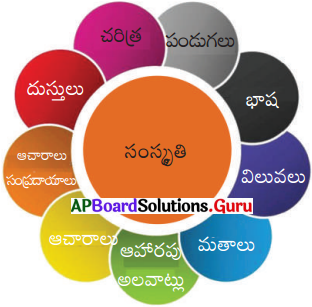


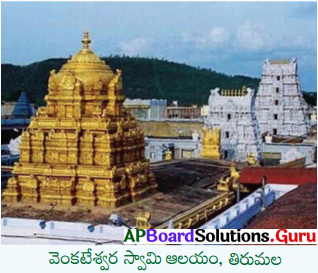
![]()
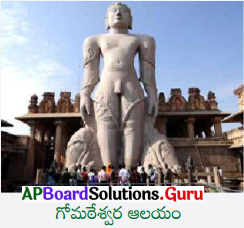

![]()

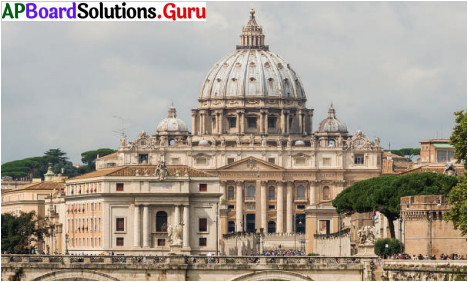
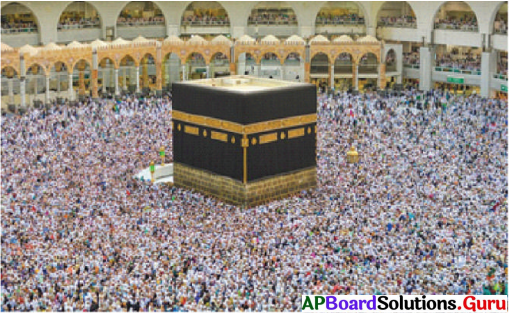

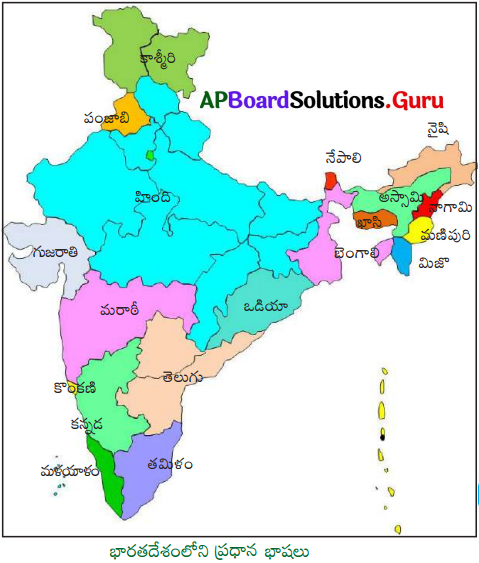
![]()
![]()
